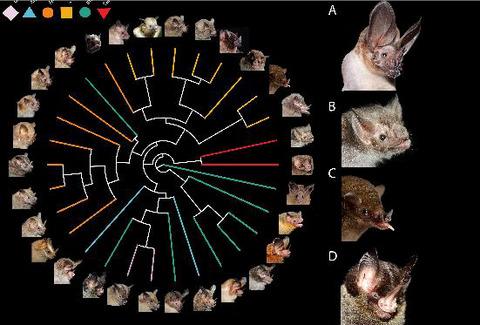当前位置:
X-MOL 学术
›
Funct. Ecol.
›
论文详情
Our official English website, www.x-mol.net, welcomes your feedback! (Note: you will need to create a separate account there.)
Morphological Diversity in the Sensory System of Phyllostomid Bats: Implications for Acoustic and Dietary Ecology
Functional Ecology ( IF 5.2 ) Pub Date : 2020-04-21 , DOI: 10.1111/1365-2435.13561 Leith B. Leiser‐Miller 1 , Sharlene E. Santana 1
Functional Ecology ( IF 5.2 ) Pub Date : 2020-04-21 , DOI: 10.1111/1365-2435.13561 Leith B. Leiser‐Miller 1 , Sharlene E. Santana 1
Affiliation

|
Handling Editor: Anthony Herrel Abstract 1. Sensory systems perform fitness-relevant functions, and specialized sensory structures allow organisms to accomplish challenging tasks. However, broad comparative analyses of sensory morphologies and their performance are lacking for diverse mammalian radiations. 2. Neotropical leaf-nosed bats (Phyllostomidae) are one of the most ecologically diverse mammal groups; including a wide range of diets and foraging behaviours, and extreme morphological variation in external sensory structures used in echolocation (nose leaf and pinnae). 3. We coupled 3D geometric morphometrics and acoustic field recordings under a phylogenetic framework to investigate the mechanisms underlying the diversification of external sensory morphologies in phyllostomids, and explored the potential implications of sensory morphological diversity to functional outputs and dietary ecology. 4. We found that the nose leaf consists of two evolutionary modules—spear and horseshoe—suggesting that modularity enabled morphological and functional diversification of this structure. 5. We found a significant association between some aspects of nose leaf shape and maximum frequency and bandwidth of echolocation calls, but not between pinnae shape and echolocation call parameters. This may be explained by the use of multiple sensory modes across phyllostomids and plasticity of some echolocation call parameters. 6. Species with different diets significantly differed in nose leaf shape, specifically in spear breadth, presence of a midrib, and cupping and anterior rotation of the horseshoe. This may relate to different levels of prey type specificity within each diet. Pinnae shape significantly differed between species that consume nonmobile, non-evasive prey (broad rounded, cupped pinnae) and mobile, evasive prey (flattened pinnae with a sharp tapering apex). This may reflect the use of different sound cues to detect prey. 7. Our results give insight into the morphological evolution of external sensory structures in bats, and highlight new links between morphological diversity and ecology.
中文翻译:

叶嘴蝙蝠感官系统的形态多样性:对声学和饮食生态学的影响
处理编辑:Anthony Herrel 摘要 1. 感觉系统执行与适应度相关的功能,而专门的感觉结构允许生物体完成具有挑战性的任务。然而,缺乏对各种哺乳动物辐射的感官形态及其性能的广泛比较分析。2. 新热带叶鼻蝙蝠(Phyllostomidae)是生态系统最多样化的哺乳动物群之一;包括广泛的饮食和觅食行为,以及用于回声定位的外部感觉结构(鼻叶和耳廓)的极端形态变化。3. 我们在系统发育框架下将 3D 几何形态测量学和声场记录相结合,以研究叶状动物外部感官形态多样化的潜在机制,并探讨了感官形态多样性对功能输出和饮食生态的潜在影响。4. 我们发现鼻叶由两个进化模块组成——长矛和马蹄铁——表明模块化使这种结构的形态和功能多样化成为可能。5. 我们发现鼻叶形状的某些方面与回声定位调用的最大频率和带宽之间存在显着关联,但耳廓形状和回声定位调用参数之间没有显着关联。这可以通过在叶状体中使用多种感觉模式和一些回声定位调用参数的可塑性来解释。6. 不同饮食的物种在鼻叶形状上有显着差异,特别是在矛的宽度、中脉的存在以及马蹄形的杯突和前旋方面。这可能与每种饮食中不同水平的猎物类型特异性有关。消耗非移动的、非回避的猎物(宽阔的圆形、杯状的耳廓)和移动的、回避的猎物(扁平的耳廓,尖尖的锥形顶端)的物种之间的耳廓形状显着不同。这可能反映了使用不同的声音提示来检测猎物。7. 我们的研究结果深入了解了蝙蝠外部感觉结构的形态演化,并突出了形态多样性与生态之间的新联系。
更新日期:2020-04-21
中文翻译:

叶嘴蝙蝠感官系统的形态多样性:对声学和饮食生态学的影响
处理编辑:Anthony Herrel 摘要 1. 感觉系统执行与适应度相关的功能,而专门的感觉结构允许生物体完成具有挑战性的任务。然而,缺乏对各种哺乳动物辐射的感官形态及其性能的广泛比较分析。2. 新热带叶鼻蝙蝠(Phyllostomidae)是生态系统最多样化的哺乳动物群之一;包括广泛的饮食和觅食行为,以及用于回声定位的外部感觉结构(鼻叶和耳廓)的极端形态变化。3. 我们在系统发育框架下将 3D 几何形态测量学和声场记录相结合,以研究叶状动物外部感官形态多样化的潜在机制,并探讨了感官形态多样性对功能输出和饮食生态的潜在影响。4. 我们发现鼻叶由两个进化模块组成——长矛和马蹄铁——表明模块化使这种结构的形态和功能多样化成为可能。5. 我们发现鼻叶形状的某些方面与回声定位调用的最大频率和带宽之间存在显着关联,但耳廓形状和回声定位调用参数之间没有显着关联。这可以通过在叶状体中使用多种感觉模式和一些回声定位调用参数的可塑性来解释。6. 不同饮食的物种在鼻叶形状上有显着差异,特别是在矛的宽度、中脉的存在以及马蹄形的杯突和前旋方面。这可能与每种饮食中不同水平的猎物类型特异性有关。消耗非移动的、非回避的猎物(宽阔的圆形、杯状的耳廓)和移动的、回避的猎物(扁平的耳廓,尖尖的锥形顶端)的物种之间的耳廓形状显着不同。这可能反映了使用不同的声音提示来检测猎物。7. 我们的研究结果深入了解了蝙蝠外部感觉结构的形态演化,并突出了形态多样性与生态之间的新联系。



























 京公网安备 11010802027423号
京公网安备 11010802027423号